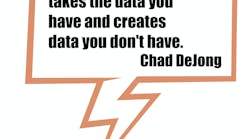Smart Industry: What is an underutilized technique for turning data into a competitive advantage?
Chad: Big data remains a buzzword that everyone talks about, and I suppose that is because data volumes continue to explode. As companies collect more and more data, analytics tools need to evolve to do more. In my opinion, the tools and techniques are not keeping pace with data. Of course, that is no fault of the software itself. There are hundreds of analytical software choices out there, both commercial and open-source, which can execute any algorithms that users can code. No, the critical path here is our own vision of how to use the data.
To begin, office professionals must challenge themselves to be more thoughtful about what business problems they want to solve. Ideally, this is done before the data is architected and collected, not after. Data scientists can implement a wide array of advanced modelling techniques, but it will be misguided without solving a specific, measurable business question.
Second, far too many companies continue to stagnate in the mindset of descriptive analytics, and they haven’t moved forward to predictive or prescriptive analytics. Descriptive analytics is essentially summarizing what already happened. “Our constraint tool experienced seven changeovers this week, two more than last week, while OEE decreased to 73%.” With predictive analytics, the goal is to build models of how the data works together, so that we might predict what might happen in the future—“Our current production plan will cause nine changeovers, so we can predict OEE on our constraint tool to be 67%.” Predictive analytics takes the data you have and creates data you don't have.
Another way to utilize data in a more powerful way it to apply it to operations-research techniques, such as dynamic simulation or optimization models. Dynamic discrete-event simulation models are built to describe the combination of multiple dependent and independent events in concurrence and over time, and as such they can be very data-thirsty. These simulation models often shine in very complex environments, where point-in-time algorithms (Neural Nets, Decision Trees, etc) can fail. Connecting discrete-event models to real-time data sources is the perfect marriage.
What are your peers using data? Discover in the 2016 State of Initiative Report.
Smart Industry: How has the world of data changed for industry/manufacturing in recent years?
Chad: The new catchphrase is “Data is the New Oil”. I’m not sure who first coined that phrase, but I’ve seen it in several major publications recently, and I tend to disagree. Oil is a finite resource, can be stored for many years, and only a handful of people can mine it. None of these are true of data. The good news is that smart manufacturing has hit the tipping point. There are now, technology-wise, many reasonable routes. Unlike ten years ago, you no longer have to invest in an intimidatingly large, complex platform. There are many choices in technology, vendors and scale.
Again, with unprecedented volumes of data, it is increasingly difficult for one person or a small group of people to sufficiently handle it. The demand is growing, as the democratization of data is a significant driver in analytics. Users demand new solutions that provide access and visibility to data. Technologies that cannot proliferate information and scale across user bases are becoming extinct.
Moving back to predictive analytics, a traditional view of mathematical model is that once a data model is built, it can be automated and you can simply watch it run and provide meaningful output for months and years to come. Data has proven to us just how quickly business drivers can change—new products, new processes, new customers, and new regulations all combine to drive the supply of new data. If you’re not constantly monitoring your tools and models for completeness and accuracy, their usefulness and application to strategic questions will soon diminish.
Chad: This second question is very tough, as every industry segment I can think of is now using data and analytics in very profound ways. Wherever there is an immediate and direct payback for analytics, (i.e., where the commodity itself is money) is where we can find cutting edge data analytics.
So, the biggest champion of data and analytics has been finance. What we call data science today has long been used to evaluate hedge funds. The gambling industry aligns to the classic theories of probability and payoffs. Retail banking and insurance are both in the business of risk management, and as such, their lifeline depends on customer analytics and product analytics.
More recently, e-commerce and media have been very active industries. They collect, analyze, and utilize customer insights by leveraging social media content on billions of mobile devices. Net Promoter Scores (NPS) are tracked and continuously updated—the willingness among customers to recommend a company or its products/services. Anyone with an account at Amazon or Netflix understands how history and personal preferences are now used instantaneously to predict future activity.
Of course, smart manufacturing is also making great strides within the Industrial Internet of Things (IIOT). Sensor-based devices can monitor industrial processes and generate a steady stream of status updates. The interpretation of this data must happen in milliseconds, so that machines are allowed to continue feeding materials, show KPI trends, or trigger interventions in case of any number of potential problems. The manufacturing industry also uses data for supply-chain management and optimization—think geographic placement of distribution centers, routing finished goods to the appropriate warehouse, locating preferred raw material vendors.
Smart Industry: How does big data prompt us to “move away from the machinery”?
Chad: As a formally trained industrial engineer and a disciple of lean manufacturing, I’ve never been completely comfortable with the idea of “moving away from the machinery”. The Gemba walk remains the first step in any continuous improvement initiative, and helps teams answer the critical question: “What business problem are we trying to solve?”
However, the spirit of this question is indeed aligned with continuous improvement. Smart manufacturing leverages digital data to solve problems and improve manufacturing performance, with insight never available or even imaginable before. This is essentially the fourth industrial revolution. It’s about big data and predictive analytics and artificial intelligence. The IIoT provides an environment of connected sensors which can gather data about the shop floor environmental conditions, current work, and equipment status. Data collected from factory equipment can help determine the health of the machinery and identify potential issues. This sort of predictive maintenance can curb lost productivity and potentially extend the life of the factory machinery.
Smart manufacturing can help us turn the focus from what the equipment is doing, to what the equipment is telling us. With smart manufacturing, the machines tell us what to do. Thus, we can constantly focus on getting more out of machinery, every minute of every day, without physically being at the machine. Traditionally, lean has been an unwilling or cautious partner with IT solutions. That is no longer the case, as data and IT solutions are almost a requirement for any modern continuous-improvement program.
Smart Industry: How does business intelligence differ from manufacturing intelligence?
Chad: There are three critical distinctions between business intelligence (BI) and manufacturing intelligence (MI):
- BI systems lack real-time integration with shop floor equipment. They look at higher level data from financial and sales focused ERP systems, while MI looks at real-time production data from shop-floor equipment. This can create confusion for who should be managing the operational reports. Should MES and historian-system owners create and manage those reports, or should they be run by the BI team, so that all reporting can be centrally managed? There are solid pros and cons to each approach.
- The level of granularity is much more significant for MI systems. BI’s day/week/year time frames are simply not acceptable for useful MI information, which needs to be at the second/minute/hour level. This supports real-time process analysis, so that key roles such as line leads or supervisors can make quick decisions based on specific KPIs in the areas of production volume, machine performance or quality levels.
- MI presents data in the context of production events and end-user activities. This helps plant-floor operators to contextualize their analysis of data with the actions they are performing. Time-slicing is a unique capability of MI that relates time-series data from process historians (think milliseconds) with production events such as changeovers, batches and equipment states.
Smart Industry: Why is visualization critical to the success of manufacturing intelligence?
Chad: Let’s face it, the average human being is an “intuitive” thinker. As we solve problems in our daily life, we think about what feels right, and often defer to our gut feeling. These feelings are usually good enough, but how do we know if they are optimal? The average human is also not very interested in looking at tables of numbers—we don’t live in a world full of actuaries and data scientists.
Given this reality, how can we help each other visualize relationships and patterns between operational and business activities? How do we identify emerging trends faster? Is it possible for a layperson to interact directly with the data?
I am constantly intrigued by how data and trends are presented. Some publications are fantastic at creatively presenting multiple dimensions on a two-dimensional screen or page, using shapes, sizes and colors together. For example, product segments can be represented by different shapes. Heat maps can illustrate upward or downward trends. Pie charts can represent both proportions and overall size simultaneously.
The end goal for both MI and BI is to enable business leaders to drill down into the data to determine the factors that are shaping operations. Real-time dashboards are a simple, powerful way to make KPIs visible on the production floor. They can engage your team by making them accountable to key metrics. They can show operators—24/7—where to focus attention and what to address. They can support a positive feedback loop, communicating the improved results from better work practices and decisions.





